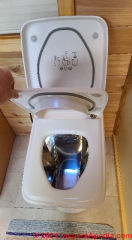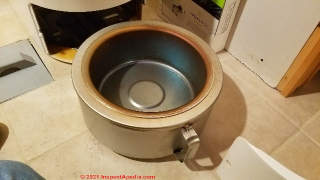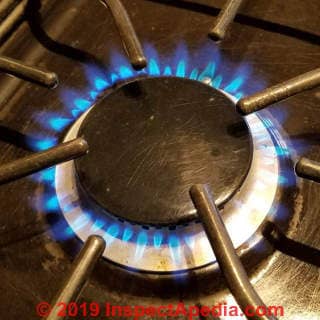 Adjust Gas Equipment for High Altitude
Adjust Gas Equipment for High Altitude
Changes needed to gas orifices, regulators, controls
- POST a QUESTION or COMMENT about what changes and adjustments are needed - if even possible - to operate LP, Propane, or natural gas fueled equipment at higher altitudes.
This article describes the use of gas fueled heating equipment of any sort when working at higher altitudes.
Some heaters, gas stoves, clothes dryers may be usable with conversion of key parts while some other equipment may not be manufacturer-certified for such use and may even be unsafe.
Our page top photo shows the gas flame lifting a bit far off of the burner on this Mapei LP gas stove operating at just under 7,000 ft. of altitude in San Miguel de Allende, Guanajuato, Mexico. We had to boost gas pressure to get another gas heating device working properly, resulting in pushing this gas stovetop a bit into question.
InspectAPedia tolerates no conflicts of interest. We have no relationship with advertisers, products, or services discussed at this website.
- Daniel Friedman, Publisher/Editor/Author - See WHO ARE WE?
High Altitude Gas Burner & Equipment Adjustments, Conversions, Manuals

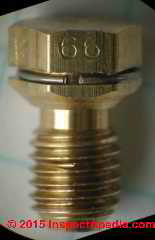 Watch out: When using a natural gas or propane-burning appliance such as a gas boiler, gas furnace, or gas stove at higher altitudes adjustments to each gas burner's metering orifices, regulator, combustion air, and venting is likely to be needed for safe use of the equipment.
Watch out: When using a natural gas or propane-burning appliance such as a gas boiler, gas furnace, or gas stove at higher altitudes adjustments to each gas burner's metering orifices, regulator, combustion air, and venting is likely to be needed for safe use of the equipment.
This is also true for gas fueled incinerating toilets, LP or propane fueled generators, etc.
Photos shown here: two different-capacity gas metering orifices, also referred to as gas spuds or jets, swapped in or out of a specific gas appliance to adjust its fuel supply rate.
The gas appliance spud will be marked with
A letter: L (for LPG) or N (for natural gas)
A number: (such as 44 or 122) indicating the orifice opening diameter that in turn defines the BTU capacity of the spud, depending further on the gas supply pressure.
These components are just one of the parts may need to be changed when swapping fuels between LP or propane and natural gas, and similarly when installing an LP gas or natural gas fueled equipment at higher altitudes.
[Click to enlarge any image]
In this article we include a collection of installation and set-up manuals for gas fueled equipment of various sorts. Each of these manuals contains detailed instructions for adjusting the gas-burning device to work properly and safely at height altitudes.
Watch out: our review of instructions for converting various gas-fired equipment to work at altitude find that almost always the requirements are very specific to the equipment brand and model and sometimes altitude as well.
Don't simply slap in a different gas regulator or orifice without following the manufacturer's instructions or your gas fueled device may well be dangerous.
Typical Changes For High Altitude Operation of Gas-Fueled Equipment
The adjustments and changes you may need to set up an LP fueled or some natural gas fueled equipment at high altitudes can include any or all of the following:
- Gas Regulators: Adjustments to the gas primary and secondary pressure regulators
- Gas spuds or jets: Changes in the gas jets or orifices through which gas is metered to each gas burner - very likely to be specific to your gas heater or appliance. The orifice size, combined with gas supply pressure and fuel type LP or natural gas, determines the input BTUh rate supplied to the individual gas burner.
These gas jet orifices (examples shown at the top of this page) are usually brass or steel devices that screw into a gas supply line feeding an individual gas burner. Numbers stamped into the metering orifice specify its BTU capacity or gas fuel flow rate. - Combustion air: Adjustments to the combustion air supply to the equipment and to the air shutters regulating combustion air to individual burners
- Exhaust Venting: Adjustments to the gas appliance or heater's exhaust venting components
- Gas Piping: Changes in the diameter of gas supply piping, depending on piping lengths as well
More arcane data must be considered by the gas fueled equipment engineers when considering specifications for high-altitude operation, such as the relationship between gas spud orifice size and gas pressure, flow, velocity, and orifice cross-sectional area.
The meaning of the orifice number sizes on gas spuds is explained in more detail
at CONVERT the GAS ORIFICES where you'll see the relationship of orifice size and the BTU rating of these devices for LP gas and natural gas.
Gas Equipment Installation Manuals Including High Altitude Set-Up Instructions
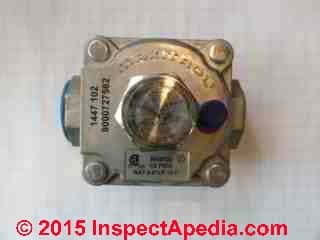 Photo: some gas regulators can be converted between fuels (LP vs natural gas) by flipping over an internal part. Other, different adjustments or even an entirely different regulator may be required to operate the same appliance at high altitude.
Photo: some gas regulators can be converted between fuels (LP vs natural gas) by flipping over an internal part. Other, different adjustments or even an entirely different regulator may be required to operate the same appliance at high altitude.
- Air-Ease / A.A.C. GAS FURNACE MANUAL Models: G2D93CT, G2D93CU, G2D95CT, & G2D95CU [PDF] Manufactured By
A.A.C.
A Lennox International Inc. Company
421 Monroe Street
Bellevue, OH 44811
This and other Air Ease HVAC equipment manuals include guidance on setting up gas furnaces for high altitude operation. - AIR QUALITY on COMMERCIAL AIRCRAFT - effects of high altitude
- ARCOAIRE AIR CONDITIONERS HEAT PUMPS GAS FURNACES
- Armstrong
A80UH & 80G1UH
UPFLOW GAS FURNACE INSTALLATION INSTRUCTIONS [PDF]
Upflow / Horizontal Left and Right Air Discharge, Op. Cit.
Excerpts:
High Altitude [operation of this Armstrong furnace]
This furnace is carefully designed for optimal performance under a wide range of operating conditions. To ensure proper operation at higher altitudes, certain adjustments and/or kits may be required.
Manifold Pressure – Between 2000 and 7500 ft, certain units require manifold pressure adjustments specified in Table 9. Manifold pressure should be measured, and adjusted as required during unit start up. Note: LP/Propane installations require a gas conversion Orifice Kit as specified in Table 10.
Pressure Switch – Between 4501 and 7500 ft, some units may require a pressure switch change. Table 10 lists the available Pressure Switch Kits providing the minimum allowable pressure switch set points, in this altitude range, for each unit. The need for a Pressure Switch Kit may be evaluated by comparing the pressure measured at the pressure switch under steady state conditions (after 15 minutes of run time) against the as shipped switch set point.
Insufficient negative pressure may lead to nuisance pressure switch trips and possible unit lock outs. Above 7500 feet, all units require both a burner orifice change and a pressure switch change per Table 10 ... [see the docunebt]
- Axeman-Anderson Centaurus GAS / OIL BOILER MANUAL [PDF] Op. Cit.
- Baxi System 35/60 & 60/100 GAS FIRED WALL MOUNT BOILER MANUAL [PDF] Baxi UK Limited
- BOND FIREPIT # 22180 MANUAL LP Gas Bowl-type Outdoor Fireplace, [original source Home Depot 2017/10/11]
- CARLIN EZGAS PRO™ Gas Burner INSTRUCTION MANUAL [PDF] Carlin Combustion Technology, Inc., 126 Bailey Road, North Haven, CT 06473 USA Phone: (203) 680-9401 Email: info@carlincombustion.com, retrieved 2017/12/31
- CINDERELLA INCINERATING TOILET at HIGH ALTITUDE
- Cooking Performance Group WOK13-LP IO MANUAL [PDF] - example of adjustments needed for operation at high altitudes - elevations
- CONSOLIDATED INDUSTRIES GAS FURNACE MANUAL [PDF] (1998), provided courtesy of InspectApedia reader J.R.
- COSMOGAS boiler / water heater combo manuals
- Eisman, John H., & Francis A. Smith, Cecil J. Merritt, THE EFFECT OF ALTITUDE ON THE LIMITS OF SAFE OPERATION OF GAS APPLIANCES [PDF] (1933) - warnings about adjustments needed and safety hazards when operating gas appliances at high altitude
Abstract: The effects of altitude have been determined, from sea level to 11,000 feet, on the limits of safe operation of nine different gas appliances operated with a mixed city gas and in one case with propane.
It was found that the maximum safe gas rate, in B.t.u. per hoour, is reduced by 3 to 4 per cent of the safe rate at sea level for each thousand feet of elevation. This reduction is about the same for all of the appliances tested with the exception of the flue passages necessary at varioius altitudes for certain types of appliances
Other data show the effects of changes in altitude on the injectin of priary air, the efficiency of the top burner f a range, the lifting of the flames from the ports, and the operation of pilot flames of both the "blue-flame" and "yellw-flame" tuy[es.
The effect of altitude in reducing the amoubt ofgas that can be burned copletely in a calorimeter was found to be the same with propane as with mixed city gas. It is concluded that the effects would have been the same had the compaison been made with other appliances or other gases.
Curves are presented which summarize the results quantitatively. - FITZGIBBONS BOILER COMPANY
- FLAME-MASTER FURNACES, Bow Valley Resources Gas Furnaces, Calgary
- GAS COOKTOP RANGE & OVEN REPAIR & MANUALS
- GAS FIREPLACE / LOG MANUALS
- GAZCO STOVAX Gas Fires
- HEARTHSTONE BOILERS also wood stoves, fireplace inserts, gas heaters
- ICG INTER CITY GAS, FURNACES
- ICP International Comfort Products CONDENSING GAS FURNACE SERVICE MANUAL Model N9MSB (B Series) (2012) Models: N9MSB0401410B
N9MSB0401712B
N9MSB0601412B
N9MSB0601716B
N9MSB0801716B
N9MSB0802120B
N9MSB1002116B
N9MSB1002122B
N9MSB1202422B
Excerpt: For proper operation and long term reliability the furnace input rate must be within +/−2 percent of input rate on furnace rating plate, or as adjusted for altitude. The gas input rate on rating plate is for installation at altitudes
up to 2000 ft. (610 M) - JOHNSON INDUSTRIAL / JOHNSON GAS APPLIANCE Co.
- LAARS Mini-Therm II RESIDENTIAL GAS FIRED BOILERS JVS, JVT IO MANUAL [PDF] retrieved 2020/02/27 original source: https://www.laars.com/images/uploads/products/1025Y-NH.pdf -
Includes explanation of adjustments needed for high altitude operation of Laars boilers - MANUALS & PARTS GUIDES - HVAC - home - Master Index to All Brand Names & A-E HVAC manuals, wiring diagrams, installation and repair guides
- RHEEM Gas Furnaces, boilers, heaters, also see Ruud
- RUUD & RHEEM Air Conditioners, Heat Pumps, Gas Furnaces
- SCHWANK GAS HEATERS / PERFECTION IR HEATERS
- Texas Furnace, Gas Furnaces, PO Box 40696, Houston TX 77240, USA, Fax: 713-466-6363, Website: http://texasfurnace.com/gas-furnaces.html
Also see TEXAS FURNACE COMPANY (a subsidiary of AllStyle Coil Company), - Thermopride HIGH-EFFICIENCY UPFLOW FURNACE INSTALLER'S INFORMATION MANUAL [PDF], retrieved 2017/09/26, original source: http://www.thermopride.com/wp-content/uploads/2014/09/422690I-TPace-VSAInstallersManual.pdf
This manual includes a section on gas furnace burner changes needed for high-altitude operation. - WILLIAMS GAS FURNACE MANUALS
- YORK TG GAS FURNACE MANUAL [PDF] (2009) Models TG9S*MP, GC9SMP - Johnson Controls Unitary Products 5005 York Drive Norman, OK 73069
Excerpt:
HIGH ALTITUDE NATURAL GAS ORIFICE CONVERSION [for York Gas Furnaces]
The National Fuel Gas Code requires that gas appliances installed above 2,000 feet elevation have their inputs de-rated by 4% per 1,000 feet above sea level.
The modulating furnaces automatically de-rate for altitude by measuring the inducer blower pressure and using that to determine if there is adequate air to support good combustion.
If there is not enough combustion air to properly support 100% of the furnace nameplate input rate, the control will reduce the input to the point that there will be good combustion.
...
Reader Comments, Questions & Answers About The Article Above
Below you will find questions and answers previously posted on this page at its page bottom reader comment box.
Reader Q&A - also see RECOMMENDED ARTICLES & FAQs
On 2022-04-13 by @C F - OK to install a Cinderella gas-fueled incinerating toilet at high altitude?
Thanks so much for your time, your recommendations and the information you provided in answer to my questions!
Now realize there are many rather obvious reasons why a propane fueled incinerator toilet designed and built to operate at lower altitudes would be very unlikely to work (or be safe) at much higher ones.
Will try reaching back out to the manufacturer to see if they may have a high-altitude conversion kit for the Cinderella Freedom toilet; or if there is any way to order one customized for our high altitude off-grid cabin.
Thanks again!! Will let you know if we receive any reply.
- The Cinderella incinerating toilet is sold in both electric and gas-powered models.
- The manufactuer has not certified that this toilet will work at high altitudes.
On 2022-04-13 by Inspectapedia Com Moderator (mod) - OK to install a Cinderella gas-fueled incinerating toilet at high altitude?
@C F,
You will absolutely want SPECIFIC gas burner adjustment requirements for the gas burner used in the Cinderella Freedom gas-fueled incinerator toilet for high altitude - that needs to come from the company's engineers. No generic explanation or "kit" is likely to be right, nor safe.
But to understand the requirement in general, you can take a look at this
LP/High Altitude LP/High Altitude Natural Gas Conversion Kit
Installation Instructions
For Model Series G Furnaces, P(G,N) Gas/Electric Appliances, and R Gas/Electric Appliances [PDF]
Watch out: This is ONLY AN EXAMPLE and NOT RIGHT for your Incinerating toilet
Excerpt: This conversion kit is only for United States installations to
convert a natural gas furnace to a propane (LP) gas application, a high altitude natural gas application, or a high
altitude propane (LP) gas application. For Canadian installations, the Canadian conversion kit must be used. - - Source: Nortek Global HVAC, retrieved 2022/04/12 original source: https://enora.nortekhvac.com/literature/707758b.pdf
At InspectApedia at
https://inspectapedia.com/plumbing/High-Altitude-NG-LP-Conversion-Kit-Instructions.pdf
Similarly, here's information from JennAir a gas cooktop and range manufacturer, on high-altitude gas burner orifice conversion kits:
Excerpt: This LP Range High Altitude Conversion Kit includes the orifices necessary to adjust your liquid propane range to operate properly in elevations that exceed 6560' (1999.5 m). At higher altitudes where air pressure is lower, cooking temperatures need to be increased to bring water to boil or thoroughly cook your food. If you’ve experienced these issues, you can update your LP range with this kit. This is a universal accessory that can be used across several brands; check to see if your model number is compatible.
Installing this accessory will require specialized tools, complicated disassembly of the range and prior repair experience. We recommend that you hire a qualified technician to install this conversion kit. If installing yourself, remember to unplug the range or shut off the house circuit breaker for the appliance before installing this part.
Also make sure to turn off the gas valve before the repair. - JennAir,LP RANGE HIGH ALTITUDE CONVERSION KIT
W11035431 - at https://www.jennair.com/parts-and-accessories/range-parts-and-accessories/p.lp-range-high-altitude-conversion-kit.w11035431.html
The reason I emphasize that you need the exactly right high-altitude conversion kit for your Cinderella gas-fueled incinerator toilet is that the LP gas metering orifices are sized specifically to meet the gas burning rate needed to match the rest of the design of the gas burner.
If the manufacturer's engineers won't or can't help you with that information, as much as I praise the Cinderella incinerating toilet line in general, I would not buy the unit as you may find that it simply won't work - won't incinerate the waste adequately - and it might be unsafe (incomplete combustion of propane or natural gas risks production of fatal carbon monoxide gas).
Watch out: keep in mind that you may need to replace or adjust (if possible) the gas regulator, and adjust combustion air and venting, not just the metering orifices.
Finally - for now - read this older but excellent article by Eiseman
The effect of altitude on the limits of safe operation of gas appliances
- Eisman, John H., & Francis A. Smith, Cecil J. Merritt, THE EFFECT OF ALTITUDE ON THE LIMITS OF SAFE OPERATION OF GAS APPLIANCES [PDF] (1933) - warnings about adjustments needed and safety hazards when operating gas appliances at high altitude
Also see information on operating LP or natural gas appliances in tall buildings or at high altitude, found at
See CINDERELLA INCINERATING TOILET for details about this device.
Below: the ash pan and pan carrier are assembled and ready to be re-installed into the toilet base.
On 2022-04-10 by C F
@Inspectapedia Com Moderator,
Thanks! Your time and offer of assistance are greatly appreciated!
On 2022-04-10 by Inspectapedia Com Moderator (mod)
@C F,
I will see what we can find.
The Cinderalla distributor, the Canadian company was very generous with me when I had complaints about a part. However I'm not sure that they have engineering staff available. That needs to come from the manufacturer.
On 2022-04-10 by C F
@Inspectapedia Com Moderator,
Thanks much for response. My inquiry to mfg in Norway via their US customer support email address was forwarded to North American distributor in Canada. All he said was they could make no guarantee of operability. Has not responded to my follow up email requesting additional details. Your observation makes sense as the gas powered generator we occasionally use required smaller carburetor jet to function satisfactorily at altitude.
Your response also made me wonder if there are adjustable propane regulators or those made for high altitudes that might help. Will look into that. Any suggestions about related references or resources would be appreciated!
On 2022-04-10 by Inspectapedia Com Moderator (mod) - use of the Cinderella Freedom (gas) incinerator toilet at higher altitude
@C F,
Worth getting some details asyou may need adjustments to gas combustion at that altitude.
Are the mfgs engineers willing to give advice?
On 2022-04-09 by C F
I'm searching for info on use of the Cinderella Freedom (gas) incinerator toilet at higher altitudes, specifically 10,500 feet. North American distributor says the product has been tested to 1050 meters (3150 feet). Anything beyond that he cannot give any guarantees. Unable to find any related research about this. Anyone have experience in use of incinerator toilets at altitude?
Any reason(s) a propane fueled incinerator toilet would not work at such an altitude? Feedback would be much appreciated.
This Q&A were posted originally
On 2020-01-22 - by (mod) - adjustment to operate gas equipment at 700 ft ? - make sense of gas consumpation rate ?
Thanks Charles for an interesting question.
Thoughts:
- the Goodman gas pack data tag will be giving INPUT BTUH which is of course a higher number than the btus of energy or heat delivered to the occupied space as combustion and heat delivery are not 100% efficient
- The gas meter can tell us, with careful reading and recording, the cubic feet of gas used over an interval
But
Unless we are keeping accurate records of the number of minutes the Goodman gas pack burner is actually on, and at which of its two input/output levels it is operating, I don't understand how we can calculate its actual natural gas usage rate.
If we have the actual on-time in hours (or fractions thereof) of the heater and if we know that it's operating at just one of its two BTU rates, then we can as I infer you're doing, calculate its anticipated usage rate and compare that with the meter's measured usage rate.
Can you give me more details about how you made your calculation?
As you cite a gas meter reading I infer that your gas supply is natural gas, not propane.
The typical BTUs in LPG and in natural gas are given
at GAS BTUH, CUBIC FEET & ENERGY
There you'll find I quote: One cubic foot (0.028 cubic meters) of natural gas contains about 1,050 BTUs - so I'm using a number slightly below yours per c.f.
I don't think the elevation at Raleigh, just 400 ft. requires a significant adjustment to the gas consumption rate as it's not far above sea level.
The relationship between altitude and gas use is addressed in an interesting paper by
- Eisman THE EFFECT OF ALTITUDE ON THE LIMITS OF SAFE OPERATION OF GAS APPLIANCES [PDF] (1933)
In any event I would be very hesitant to change the gas orifices in the heater from what was installed by the factory. I think that there are multiple design features that are balanced by the heater's design engineers.
So unless the Goodman unit's instructions (or a call to Goodman's tech support) allow us to change the orifice sizes and thus gas metering rates, I would not do so as it could make the unit unsafe.
In addition to reading the details of how you are making your calculation it'd be helpful to know the Goodman gas pack model and to see a photo of the unit's data tag (you can use the "add image" button to add one photo per comment).
Thanks
Daniel
For other readers
A "Gas pack" is a heating and cooling unit that provides heat by burning gas, LPG or NG, and provides cooling by using electricity.
The photo below is of a Goodman GPG16M gas pack unit
Cooling Capacity: 22,800 – 58,500 BTU/h
Heating Capacity: 60,000 – 140,000 BTU/h
Product specifications for Goodman Gas Pack units GPG 1624 to GPG 1660 are given by
GOODMAN GAS PACK SPECIFICATIONS [PDF] at InspectApedia.com
Charles' unit is perhaps the Goodmanb GPG1630 with orifice sizes 45 / 1.25MM and an AFUE of 81%
In that unit the two firing ranges give these INPUT/OUTPUT BTU numbers
Low-fire rate 60,000 / 47,000 BTUh
High-fire rate 80,000 / 62,000 BTUh
Image Lost, please re-post.
On 2020-01-22 by Charles
Hello, I have a new (one month) Goodman gas pack. It has a two stage gas burner, rated at 80,000/60,000 btu on natural gas.
The gas pressure has been double checked and set at exactly what is on the nameplate (ie: 3.5" w.c. and 2.0 w,c.).
Elevation here in Raleigh is about 400'. The problem is that by checking the gas consumption on the gas meter, using a btu content of 1020 btu/c.f., the unit is using only about 63,000/50,000 btu on highfire/low fire.
I'm just wondering if perhaps the orifaces are not the correct size, or perhaps the gas pressures should be increased above Goodman's suggestions.
...
Continue reading at GAS PRESSURE vs BUILDING HEIGHT, or select a topic from the closely-related articles below, or see the complete ARTICLE INDEX.
Or see these
Recommended Articles
- BLUE vs YELLOW COMBUSTION FLAMES
- COMPLETE COMBUSTION, STOICHIOMETRIC
- CONVERT the GAS ORIFICES - change between LP Propane & Natural Gas; changes for high altitude gas appliance or heater operation
- GAS APPLIANCE CONVERT LP-to-NATURAL GAS
- GAS APPLIANCE OPERATION at HIGH ALTITUDE
- GAS BURNER FLAME & NOISE DEFECTS
- GAS BURNER SOOT CAUSE & CURE
- GAS BURNER PILOT LIGHT PROCEDURE
- GAS REGULATORS & APPLIANCE / HEATER CONTROLS - also need adjustment for tall buildings or high altitude
- GAS REGULATOR ADJUSTMENT PROCEDURE
- GAS REGULATOR CONVERSION NG-LP
- GAS PRESSURES LP vs NATURAL GAS
- GAS PRESSURE vs BUILDING HEIGHT - LP or propane fueled equiopment djustments needed to allow for altitude?
- GAS REGULATORS & APPLIANCE / HEATER CONTROLS
Suggested citation for this web page
GAS APPLIANCE OPERATION at HIGH ALTITUDE at InspectApedia.com - online encyclopedia of building & environmental inspection, testing, diagnosis, repair, & problem prevention advice.
Or see this
INDEX to RELATED ARTICLES: ARTICLE INDEX to GAS APPLIANCES, PIPING, CONTROLS
Or use the SEARCH BOX found below to Ask a Question or Search InspectApedia
Ask a Question or Search InspectApedia
Try the search box just below, or if you prefer, post a question or comment in the Comments box below and we will respond promptly.
Search the InspectApedia website
Note: appearance of your Comment below may be delayed: if your comment contains an image, photograph, web link, or text that looks to the software as if it might be a web link, your posting will appear after it has been approved by a moderator. Apologies for the delay.
Only one image can be added per comment but you can post as many comments, and therefore images, as you like.
You will not receive a notification when a response to your question has been posted.
Please bookmark this page to make it easy for you to check back for our response.
IF above you see "Comment Form is loading comments..." then COMMENT BOX - countable.ca / bawkbox.com IS NOT WORKING.
In any case you are welcome to send an email directly to us at InspectApedia.com at editor@inspectApedia.com
We'll reply to you directly. Please help us help you by noting, in your email, the URL of the InspectApedia page where you wanted to comment.
Citations & References
In addition to any citations in the article above, a full list is available on request.
- Our recommended books about building & mechanical systems design, inspection, problem diagnosis, and repair, and about indoor environment and IAQ testing, diagnosis, and cleanup are at the InspectAPedia Bookstore. Also see our Book Reviews - InspectAPedia.
- In addition to citations & references found in this article, see the research citations given at the end of the related articles found at our suggested
CONTINUE READING or RECOMMENDED ARTICLES.
- Carson, Dunlop & Associates Ltd., 120 Carlton Street Suite 407, Toronto ON M5A 4K2. Tel: (416) 964-9415 1-800-268-7070 Email: info@carsondunlop.com. Alan Carson is a past president of ASHI, the American Society of Home Inspectors.
Thanks to Alan Carson and Bob Dunlop, for permission for InspectAPedia to use text excerpts from The HOME REFERENCE BOOK - the Encyclopedia of Homes and to use illustrations from The ILLUSTRATED HOME .
Carson Dunlop Associates provides extensive home inspection education and report writing material. In gratitude we provide links to tsome Carson Dunlop Associates products and services.


